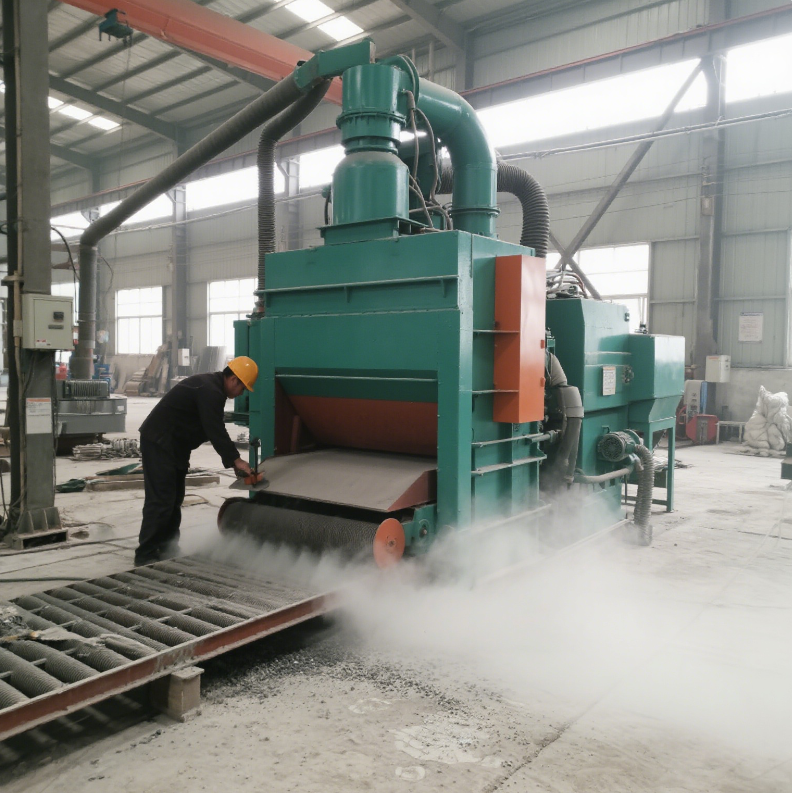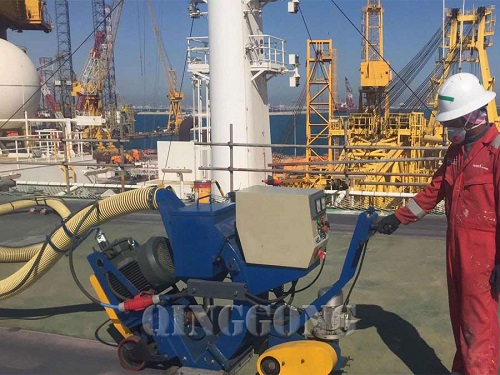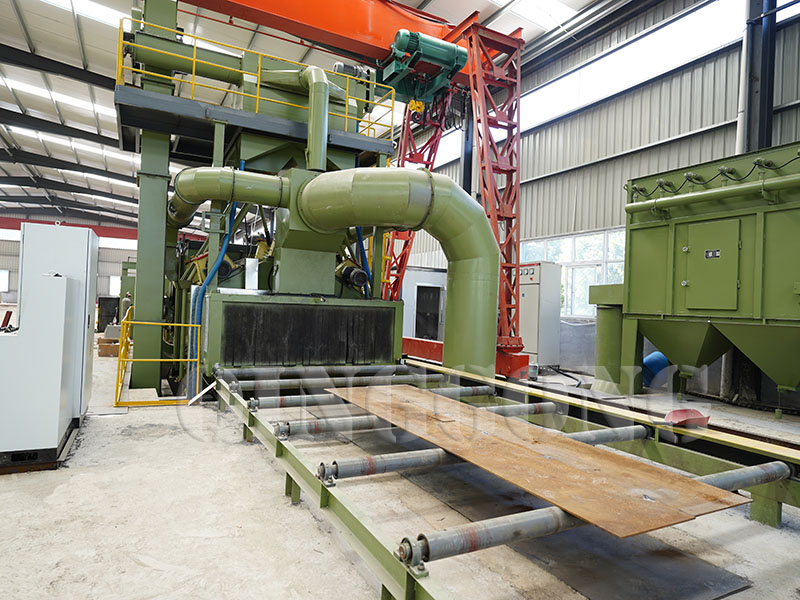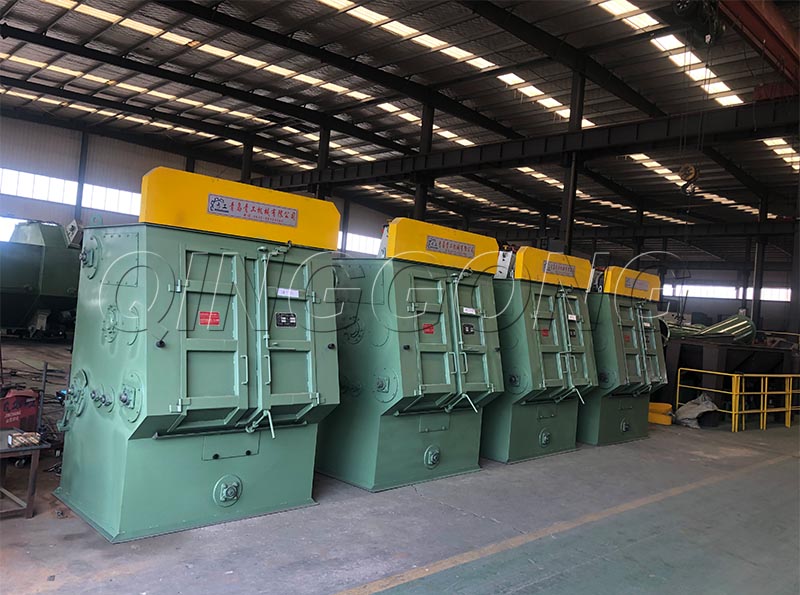In industries that require surface cleaning and finishing—such as automotive, aerospace, manufacturing, and construction—shot blasting and grit blasting are two of the most commonly used techniques. Though both processes aim to clean and prepare surfaces for further treatments like coating or painting, they do so using different approaches, abrasive materials, and methods. Understanding these techniques is crucial when deciding which one to use for specific applications.
In this blog, we’ll compare shot blasting and grit blasting in terms of their processes, differences, advantages, and common applications, helping you make an informed decision about which method best suits your needs.
What is Shot Blasting?
Shot blasting is a surface preparation technique that involves propelling small, spherical steel balls (referred to as “shots”) at high velocity toward a surface. This process is carried out in a closed machine, typically using a centrifugal wheel or air pressure to launch the steel shots at the surface of the material. As the shots collide with the surface, they remove dirt, rust, paint, or other contaminants, leaving a clean, smooth finish.
The technique is typically used for cleaning large, industrial parts made from steel, aluminum, or other metals. Shot blasting is often employed to prepare surfaces for coating, painting, or further mechanical processes.

What is Grit Blasting?
Grit blasting, also known as abrasive blasting, involves the use of hard, angular materials (known as abrasives or grit) such as sand, aluminum oxide, or glass beads, which are shot at a surface using compressed air or another blasting system. Unlike shot blasting, which uses spherical steel shots, grit blasting relies on angular abrasives that are more effective at abrading, roughening, and texturing surfaces.
Grit blasting is ideal for surface profiling, cleaning, roughening, and texturing purposes. The technique is commonly used in industries such as aerospace, shipbuilding, automotive repair, and construction, where precision, etching, and coating adhesion are essential.

Key Differences Between Shot Blasting and Grit Blasting
While shot blasting and grit blasting are both used for cleaning and finishing surfaces, they have several differences that set them apart. Let’s explore these key distinctions in more detail:
1. Abrasive Materials
The most significant difference between shot blasting and grit blasting is the type of abrasive material used.
As the name suggests, shot blasting utilizes spherical steel shots. These shots are made of hardened steel and are round in shape, allowing them to produce a smooth, uniform surface finish. Steel shots are reusable, making them a cost-effective option for high-volume applications.
Grit blasting, on the other hand, uses angular abrasives such as sand, aluminum oxide, or glass beads. The angular shape of the grit particles makes them more aggressive when impacting a surface. This aggressiveness results in a rougher finish and a more abrasive cleaning action, which is ideal for applications where surface profiling is important, such as preparing a surface for coating.
2. Surface Finish
The shape of the abrasive particles directly influences the surface finish achieved.
Steel shots provide a smoother, more polished finish because their spherical shape does not cause deep scratching or roughness on the surface. Shot blasting is ideal when the goal is to clean metal surfaces while maintaining a smooth texture, often for aesthetic or functional purposes.
The angular shape of grit particles results in a rougher, more textured finish. Grit blasting is often used for applications that require increased surface roughness to improve the adhesion of coatings, paints, or primers. For instance, when preparing a metal part to be powder-coated or painted, grit blasting ensures the paint sticks better by creating a profile for better bonding.
3. Speed and Efficiency
Shot blasting tends to be faster and more efficient than grit blasting in certain applications.
Since steel shots are reusable, shot blasting is more cost-effective for large-scale operations. The process is faster, making it suitable for cleaning large metal parts and structures in a relatively short time.
Grit blasting, while highly effective for creating textured surfaces, typically requires more abrasive material, which might not be reusable. As a result, it can be slower and more expensive than shot blasting, especially for large-scale projects.】
4. Applications
Both shot blasting and grit blasting have distinct applications depending on the surface preparation required.
Shot blasting is commonly used for removing rust, old paint, scale, or dirt from metal surfaces. It is particularly useful for cleaning large components like automotive parts, steel beams, industrial machinery, and tanks. Additionally, shot blasting is used in processes like surface hardening and shot peening, where metal parts are subjected to compressive stress to increase their resistance to fatigue.
Grit blasting excels in situations that require surface profiling, such as preparing a metal surface for painting or coating. It is also used in industries where the texture of the material is important, such as in the cleaning of glass, stone, or concrete surfaces. Grit blasting is essential for applications that require a rough or etched surface, such as preparing parts for adhesive bonding or creating non-slip surfaces on walkways.
5. Cost Considerations
The cost of shot blasting and grit blasting can vary based on the materials used and the specific project requirements.
Shot blasting can be more cost-effective in the long run because the steel shots used are highly durable and can be reused many times. This makes it ideal for large projects where efficiency and volume are key factors.
Grit blasting, while effective, tends to be more expensive due to the consumable nature of the abrasive material. Depending on the type of grit used, it may need to be replaced frequently, which can increase overall costs. However, for smaller, more precise work, grit blasting may provide better value.
| Feature | Shot Blasting | Grit Blasting |
| Abrasive Material | Spherical steel shots | Angular abrasives (sand, aluminum oxide, glass beads) |
| Surface Finish | Smooth, polished finish | Rough, textured finish |
| Surface Preparation | Removes rust, dirt, paint, and scale, while maintaining smoothness | Profiles, roughens, and etches surfaces |
| Common Applications | Metal cleaning, surface hardening, shot peening, paint removal | Surface profiling for coatings, cleaning delicate parts, etching materials like glass or stone |
| Speed & Efficiency | Faster, especially for large components, due to reusable shots | Slower, as abrasives are less reusable, higher material consumption |
| Cost | More cost-effective for high-volume, large-scale operations due to reusable abrasive material | Can be more expensive due to the need for frequent replacement of abrasives |
| Ideal For | Cleaning and finishing metal parts like automotive components and machinery | Surface preparation for coating or painting, texturing materials like concrete, glass, or stone |
| Surface Texture | Smooth, even finish without deep scratches | Rougher texture ideal for improving coating adhesion or creating non-slip surfaces |
| Material Types | Primarily metals (steel, aluminum, etc.) | Versatile: metals, concrete, stone, glass, and more |
| Cost-Effectiveness | High cost-efficiency for large parts with reusable shots | Less cost-effective for large-scale operations due to abrasive replacement |
Choosing the Right Method for Your Needs
Choosing between shot blasting and grit blasting depends on the specific requirements of your project. Consider the following factors when making your decision:
Surface Texture: If you need a smooth, clean surface with minimal texture, shot blasting is the better option. If you need a rough, textured surface for better adhesion or etching, grit blasting will be more effective.
Material and Size of the Object: Shot blasting is ideal for large, heavy-duty metal parts and surfaces. Grit blasting is more versatile and can be used on a variety of materials, including metals, stone, glass, and concrete.
Cost: For high-volume applications where abrasives can be reused, shot blasting is typically more cost-effective. Grit blasting may incur higher costs, especially if you require a large amount of abrasive material.
FAQs about Shot Blasting
1.Is shot blasting easy?
Shot blasting is a highly effective surface preparation technique, but its ease depends on the equipment used and the operator's expertise. Modern automated shot blasting machines simplify the process, allowing for consistent and efficient treatment of surfaces with minimal manual intervention. However, understanding the appropriate settings, such as blast media type, machine speed, and exposure time, is crucial for optimal results. While the process can be straightforward with proper training and equipment, achieving the desired surface finish requires attention to detail and adherence to safety protocols. Therefore, while shot blasting can be easy to perform, mastering it necessitates experience and knowledge.
2.Does shot blasting remove rust?
Yes, shot blasting is an effective method for removing rust from metal surfaces. The process involves propelling abrasive materials, such as steel shots or grits, at high velocities onto the surface, effectively dislodging rust, scale, and other contaminants. This not only cleans the surface but also prepares it for subsequent treatments like painting or coating by creating an ideal profile for adhesion. Shot blasting is widely used in industries such as automotive, construction, and shipbuilding for rust removal and surface preparation, ensuring the longevity and integrity of metal components.
3.Is shot blasting noisy?
Shot blasting operations are inherently noisy due to the high-speed impact of abrasive materials against surfaces and the mechanical components involved. Noise levels can vary depending on the equipment and materials used but often exceed 85 decibels, which is considered potentially harmful with prolonged exposure. To mitigate noise, facilities may implement soundproofing measures, use noise-dampening materials, and ensure regular maintenance of equipment. Operators are advised to wear appropriate hearing protection and adhere to occupational safety guidelines to minimize the risk of hearing damage during shot blasting activities.
4.What material is used for shot blasting?
Shot blasting utilizes various abrasive materials, selected based on the specific application and desired surface finish. Common abrasives include:
Steel Shot: Spherical particles ideal for peening and creating smooth finishes.
Steel Grit: Angular particles suitable for aggressive cleaning and surface profiling.
Aluminum Oxide: A hard, reusable abrasive used for cleaning and surface preparation.
Glass Beads: Provide a smooth, bright finish, often used for cosmetic applications.
Cut Wire: Precisely sized metallic particles used for consistent results in peening.
FAQs about Grit Blasting
1.What is the hazard of grit blasting?
Grit blasting poses several hazards, primarily due to the high-speed abrasive particles used. Inhalation of dust can lead to serious respiratory issues like silicosis or lung damage, especially if silica-containing materials are used. Eye and skin injuries from flying particles are also risks. Additionally, noise exposure and potential contact with toxic substances on the surface being blasted make proper protective gear and ventilation essential for safety.
2.What Types Of Abrasive Can I Use For Grit Blasting?
Aluminum Oxide – durable and reusable, great for hard surfaces.
Glass Beads – gentle, used for polishing and finishing.
Silicon Carbide – very hard, ideal for tough jobs.
Steel Grit or Shot – aggressive, used for heavy-duty cleaning.
Garnet – environmentally friendly and effective for cutting and cleaning.
Plastic Abrasive – used on softer substrates like aluminum or composites.
 EN
EN
 fr
fr  de
de  es
es  it
it  ru
ru  pt
pt  ar
ar  th
th  pl
pl  ro
ro 


